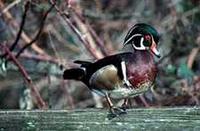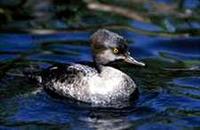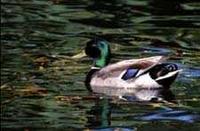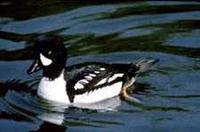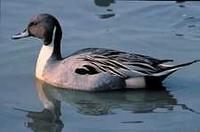Duck
DUCK is a small waterfowl with short legs, webbed feet, flat bill and highly varied plumage. Ducks are among the most common shorebirds in the province. Most species are strong flyers and migrate each year from their northern and Interior nesting grounds to winter along the milder coast. They inhabit a variety of WETLANDS—sloughs, marshes, ponds, lakeshores, ESTUARIES and streams—and inshore waters along the coast. Strictly speaking the females are ducks; males are called drakes. Conventionally ducks are divided into 3 groups according to feeding habits: the dabbler, the most colourful, feeds on the surface or by submerging its head and body in shallow water until only its upright tail remains visible; the diver plunges completely below the surface; the merganser dives to pursue fish. Of the 30 species occuring in BC, mallards (Anas platyrhynchos) are the most widespread and abundant, breeding almost everywhere there is open water. The female has nondescript mottled brown plumage; the male is marked by its iridescent green head and chestnut breast. Mallards are the most important game ducks for hunters, and their adaptability to changes in their habitat makes them familiar denizens of urban areas. Other dabblers include 3 species of teal, the smallest duck: green-winged teal (Anas crecca), cinnamon teal (A. cyanoptera) and blue-winged teal (A. discors); the wood duck (Aix sponsa); the northern pintail (Anas acuta), vast numbers of which migrate down the coast from Alaska every year; the northern shoveler (A. clypeata); the gadwall (A. strepera); and 2 species of wigeon, the Eurasian wigeon (A. penelope) and the American wigeon (A. americana), one of the most abundant winter visitors to the coast, especially in the FRASER R delta. Diving species include the large canvasback (Aythya valisineria), the redhead (A. americana)—the only species that winters more in the Interior than along the coast — the ring-necked duck (A. collaris), the tufted duck (A. fuligula), the greater scaup (A. marila), the lesser scaup (A. affinis), the quite rare king eider (Somateria spectabilis), the harlequin duck (Histrionicus histrionicus), the oldsquaw (Clagnula hyemalis), the black scoter (Melanitta nigra), the surf scoter (M. perspicillata), the white-winged scoter (M. fusca), the common goldeneye (Bucephala clangula), the Barrow's goldeneye (B. islandica), the bufflehead (B. albeola) and the ruddy duck (Oxyura jamaicensis). Mergansers are identifiable by their slender, round bills, hooked at the tip, and their tufted heads. They include the hooded merganser (Lophodytes cucullatus), common merganser (Mergus merganser) and red-breasted merganser (M. serrator).

